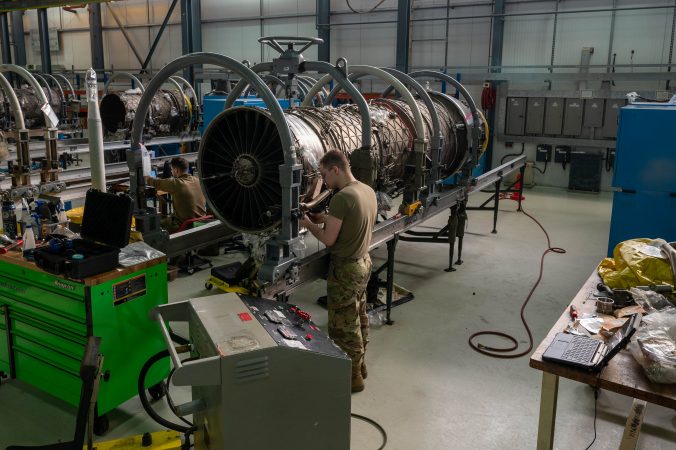A known “blind spot” in F-16 engines meant maintainers couldn’t see one turned vane inside an aircraft at Holloman Air Force Base, N.M.—damage that resulted in engine failure and a crash that destroyed the $21 million fighter in April 2024, according to a new Air Force report.
The F-16C lost thrust shortly after takeoff, and when the pilot, a rated instructor, could not regain powe following established procedures, he ejected, suffering only minor injuries as he landed near White Sands National Park, officials determined in an Accident Investigation Board report released Feb. 5.
The F-16 took off from Holloman as part of a four-ship training formation. Seconds after takeoff, the pilot “heard a loud bang and felt a loss of thrust, violent shaking, and engine vibrations,” he told investigators.
A civilian on the ground, and other pilots in the air, told officials they saw fire or a “strange, non-standard, orangish color” coming from the rear of the jet. When recovery procedures failed, the pilot ejected at 1,460 feet, less than two minutes into the flight. The aircraft crashed into a sand dune and exploded and the pilot was quickly recovered by an Army helicopter.
The investigation estimated the total damage at $21.7 million.
The engine was an F100-PW-220, built by Pratt & Whitney. The investigation studied maintenance records; ordered debris examined at the F-16 depot at Tinker Air Force Base, Okla., commissioned an analysis by Pratt, and interviewed expert maintainers, instructors, and an aerospace engineer.
Investigators concluded that deep within the engine, in its fifth stage, a small “vane” was turned “about 25 degrees more open than adjacent vanes.” This caused “abnormal aerodynamic forces” to stress one of the fifth stage’s blades, leading to its breakage. Once that happened, airflow was disrupted and the engine failed.
Investigators were inconclusive on what caused the vane to be turned out of position. The engine had experienced a foreign object damage (FOD) event in August 2022 that damaged the first stage of the inlet fan, but no damage was observed on stages 2-4 or 6-13.
Pratt & Whitney’s analysis cited the FOD event as the probable cause of the vane turning. But other expert opinions varied when asked if it was possible for damage to occur to a later stage if no damage was observed in the ones before it.
“A field-level engine maintainer with forty-three years around F100 engines testified, ‘it happens, it’s kind of unexplainable … but it’s frequent enough that we all have seen’ instances,” the report states. “A field-level engine and borescope instructor [,however,] had never seen this occur. An experienced depot maintainer said it could happen but was very rare. Finally, a depot aerospace engineer said it would be surprising if it occurred.”
Investigators also looked at the possibility of the vane being improperly aligned or moved during depot-level maintenance, but maintainers told them it was unlikely as such vanes cause the entire stage to “bind” and not pass quality control checks.
“I find the cause for the turned vane impossible to determine,” the AIB president concluded.

Crucially, field maintainers would not have been able to see the turned vane even if they were looking for it.
“Due to the F100-PW-220 engine’s absence of an access port permitting a fifth stage borescope inspection, the fifth stage is only inspected through engine core teardown and HPC disassembly accomplished during depot-level maintenance,” the report states.
The last time the engine had been in depot maintenance was in 2016 and it “was approaching” its next overhaul at the time of the accident, officials stated without disclosing the precise date.
Maintainers did not send the engine to the depot after the FOD event because they could not see any damage to stages 2-4 or 6-13, and subsequent inspections revealed no issues with those stages. It is possible that stage 5 was damaged, but they could not check as they would for other stages. This was standard operating procedure.
“Field-level maintenance correctly performed all required engine repair and inspection tasks; therefore, the engine was returned to service,” investigators wrote. “No field-level indications would have triggered the removal of the engine for shipping to the depot for unscheduled maintenance of the fifth stage.”
Lack of access to the fifth stage for field-level maintainers is a “known ‘blind spot,’” officials said. The F-16 program office in the Air Force Life Cycle Management Center has already conducted a “deliberate risk assessment” as to whether the engine needs to be sent to the depot for unscheduled maintenance if the stages surrounding the fifth stage show no signs of damage.
“The risk assessment is based on the historical and anticipated probability of damage before scheduled maintenance compared to the severity of possible adverse effects. This deliberate risk assessment is informed by the limited time, manpower, and funding available to pull an engine out of an aircraft in the field, ship it to depot-level maintenance, perform a teardown, inspect it and make repairs (if any), reassemble it, ship it back to the field, and reinstall it into an aircraft,” the report states.
The accident investigation board makes no mention of whether the program office is revisiting that assessment after the mishap, and an AFLCMC spokesperson was not immediately able to provide comment from the program office.
